|
“Was This The First USAF Inflight |
||||||
|
During the Korean War and the Early Cold War period, the 91st Strategic Reconnaissance Squadron at Yokota AFB, Japan, was often the host for special mission activities. This story provides added evidence to back up this statement. It details how an RB-29 crew, with minimum orientation and preperation time, found themselves participants in a ground-breaking experiment involving the use of new and developing air refueling technology using the probe and drogue procedure. Other historians, accumulating their evidence through research, have identified this history-making event as having taken place at dates other than as reported in this story. Captain Jack Romney, RB/KB-29 Aircraft Commander presents his evidence here. Following his story, we will present what references that are available to us that appear to be in conflict. Anyone in our viewing audience who can add credible evidence to this case, is encouraged to contact Jack H. Romney, 18 Park Avenue, Vero Beach, Florida 32960, Chuck Stone, Web Site Developer and Manager |
||||||
|
In the summer of 1951, three KB-29 tankers were attached to the 91st SRS Squadron at Yokota AFB, Japan. These tankers were equipped with the probe and drogue flight refueling system developed and provided by Flight Refueling, Ltd., an English company. Their mission was to become familiar with theater operations and proficient with their equipment and then proceed to K-13 (as I recall), an F-84 fighter/bomber base in Korea. From the base they were to refuel F-84’s stationed at K-13 in-flight during their attacks on targets in North Korea. Two basic missions were envisioned: 1) Refuel the F-84’s after they had taken off with a minimum fuel load and a maximum munitions load, and 2) Circle downed pilots and refuel wingmen so they could provide cover until rescue operations could be effected. After several weeks two of the tanker crews were ready but the third had made little progress. The Squadron C.O. called me into his office and asked me if I and my crew would take over the tanker and it’s mission. (My RB-29 was undergoing periodic maintenance.) We accepted the assignment and after a shakedown flight to become accustomed to the airplane and its equipment we joined the other two KB-29’s and proceeded to K-13, an F-84 fighter/bomber base with a pierced steel planking runway about 8,500 ft. long. Operating from the same base as the F-84’s, we successfully completed several of both types of missions and returned to Yokota AFB. All of these were combat missions above the bomb line. The attached records (see URL at bottom of page) describes what they refer to as the first USAF flight refueling in combat flown from Japan in 1952. Clearly the mission I participated in was earlier, hence the first. I no longer have my AF records, so I would appreciate learning of anyone or any records corroborating the facts above: e.g., F-84 units participating, name of the fighter base, names of fellow tanker crewmen, their unit designation, in Flight Refueling, Ltd. is still in existence where they can be contacted, etc. If our mission was first, I would like for the record to say so. Jack Romney Editor’s Note Regarding Conflicting Data The Tactical Air Warfare section of the WPAFB Museum exhibit on the Korean Conflict included this statement: “The first combat use of air-to-air refueling of USAF fighter airplanes took place on May 29, 1952, when twelve F-84E’s of the 159th Fighter-Bomber Squadron flew a bombing mission from Itazuke Air Base in Japan against targets at Sariwon, North Korea. “The planes were refueled by KB-29 tankers after they had bombed their targets and were homeward bound. By July 4, 1952, three more of these “Operation Hightide” missions had been flown. The F-84Es had probes sticking out in front of their tip tanks for use with drogues trailing on hoses from the KB-29s.” [See URL below] There is a story, published by Major Vernon B. Byrd, USAF Retired, entitled “Passing Gas — The History of In-flight Refueling” that speaks to this subject. On pages 88 and 89 of the story, he states: “On July 6, 1951, the first in-flight refueling over enemy territory occurred when a KB-29M of the Air Material Command, but operated by a SAC crew from the 43rd Air Refueling Squadron, refueled four F- 80 Shooting Stars who were flying reconnaissance missions over North Korea. The tanker was flying out of Yokota AB, Japan and was temporarily assigned to the 91st Strategic Reconnaissance Squadron, Medium, Photographic.” Later, on page 89 he states: “The History of SAC, 1946-1981, correctly states on page 32 that combat refueling operations were begun during the Korean War.” The Texas National Guard Public Affairs Web Site, in their section on the Korean War, has a photo of F-84E # FS-229, taken on the ramp at Taegu, South Korea. The period of the photo is 1951. The explanation reads: “F-84Es on the ramp at Taegu, South Korea, bear tip-tank refueling probes. The 111th Fighter Bomber Squadron and sister units in the “Texas Wing” were among the first in the world to perform aerial refueling in combat.” [See URL below.] |
||||||
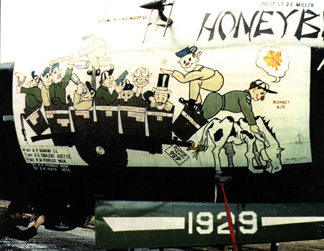 |
||||||
|
All photos Ctsy Jack Romney |
||||||
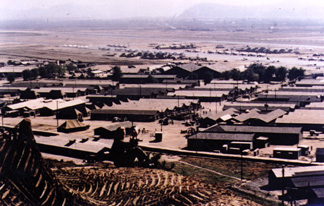 |
||||||
|
Foreground Copilot Lt. Don E. Miller |
||||||
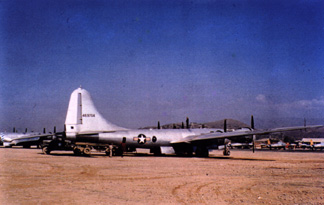 |
||||||
|
Summer 1951 |
||||||
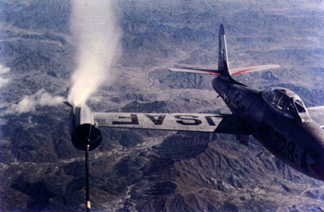 |
||||||
|
is full - pilot is disengaging probe. |
||||||
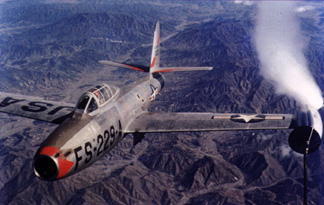 |
||||||
|
|
||||||
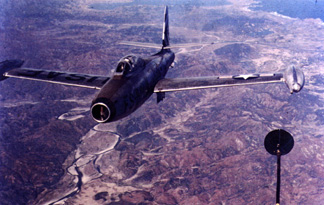 |
||||||
|
|
||||||
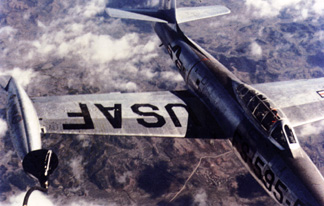 |
||||||
|
|
||||||
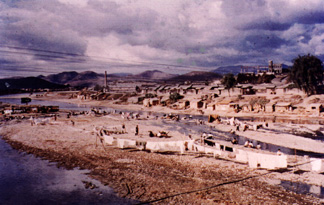 |
||||||
|
|
||||||
| If you wish to visit the WPAFB Museum web site page dealing with this issue, as described above, try URL http://www.wpafb.af.mil/museum/history/korea/kc6.htm
There are a series of e-mails and letters going back and forth that provide additional scraps of information and conjecture that are too complex to be published here. Beyond sharing this interesting story, the main issue here is “Can you, or anyone or agency you know, shed added light on the questions involved here?” If so, please be in touch with Jack Romney (contact information at top) by mail or telephone and share any input you may have. Thank You! Chuck Stone, Web Site Developer and Manager
Home - Contact Us - Cold War Hist. - 91st SRS Hist. - Stardust 40 Mission Story |
||||||